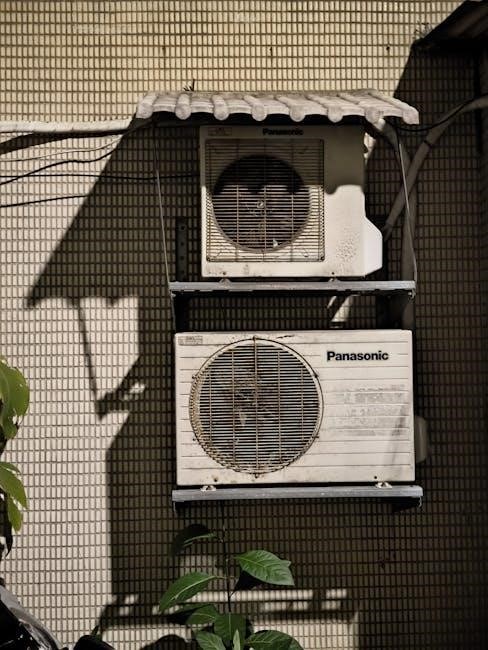Panasonic ducted air conditioning systems offer superior cooling performance and energy efficiency, designed for both residential and commercial spaces. Their innovative technology ensures optimal comfort and reliability.
1.1 Overview of Panasonic Ducted Air Conditioning
Panasonic ducted air conditioning systems are renowned for their innovative design, high-quality performance, and energy efficiency. These systems are ideal for both residential and commercial spaces, offering a centralized cooling solution. They feature advanced inverter technology, smart sensors, and quiet operation. The ducted design allows for concealed installation, providing consistent airflow and temperature control across multiple zones. Panasonic’s systems are also compatible with smart home integration, enhancing convenience. Comprehensive installation and operating manuals are available, ensuring seamless setup and maintenance for optimal functionality and comfort.
1.2 Benefits of Ducted Air Conditioning
Panasonic ducted air conditioning systems provide energy efficiency, reducing power consumption while maintaining consistent temperatures. They operate quietly, ensuring minimal noise disruption. The ducted design allows for concealed installation, enhancing aesthetic appeal. Advanced inverter technology optimizes performance and energy savings. Smart home compatibility enables seamless integration with modern automation systems. Zone control capabilities offer tailored comfort for different areas. These systems are designed for long-term reliability, with robust construction and superior cooling performance, making them a popular choice for both residential and commercial applications.
1.3 Key Features of Panasonic Ducted Systems
Panasonic ducted systems feature advanced inverter technology for energy efficiency and consistent temperature control. Smart sensors optimize airflow and operational modes, ensuring comfort and energy savings. The systems are designed for quiet operation, with noise levels minimized for a peaceful environment. They also offer compatibility with smart home systems, enabling remote control and automation. Additionally, Panasonic ducted systems include robust construction, reliable performance, and user-friendly interfaces. These features ensure long-term durability and superior cooling performance, catering to both residential and commercial needs effectively.

Components of Panasonic Ducted Air Conditioning Systems
Panasonic ducted systems include indoor units, outdoor units, ducting, and ventilation components, designed for efficient air distribution and seamless integration into residential and commercial spaces.
2.1 Indoor Unit Components
The indoor unit of Panasonic ducted air conditioning systems includes key components such as the evaporator coil, blower fan, and air filter. These elements work together to circulate cooled or heated air through the ductwork. The evaporator coil absorbs heat from the room, while the blower fan ensures efficient airflow distribution. The air filter helps maintain air quality by trapping dust and allergens. Proper maintenance of these components is essential for optimal system performance and energy efficiency.
2.2 Outdoor Unit Components
The outdoor unit of Panasonic ducted systems contains essential components like the compressor, condenser coil, fan, and control module. The compressor compresses refrigerant, while the condenser coil dissipates heat. The fan ensures proper airflow for efficient cooling. These components are housed in a durable, weather-resistant casing. Regular maintenance, such as cleaning the condenser coil, is crucial for optimal performance. The outdoor unit operates quietly and efficiently, making it suitable for various installations.
2.3 Ducting and Ventilation Components
The ducting system in Panasonic ducted air conditioning distributes conditioned air throughout the space via insulated ducts. Key components include supply and return air ducts, vents, and grilles. Properly sized and insulated ducts ensure efficient airflow and minimize energy loss. The system also includes dampers for airflow control and balancing. Regular cleaning and maintenance of ducts are essential to prevent dust buildup and ensure optimal performance. Proper installation and sealing of ducts are critical for system efficiency and indoor air quality.
2.4 Remote Control and Sensors
The remote control for Panasonic ducted systems offers intuitive operation, allowing users to adjust temperature, airflow, and operating modes. Advanced sensors monitor room conditions, optimizing performance and energy use. The remote typically includes features like timer functions, quiet operation modes, and airflow direction control. Sensors ensure precise temperature regulation and automatic adjustments for comfort. Proper use of the remote and sensor technology enhances system efficiency and user convenience, providing a seamless cooling experience tailored to individual preferences. Regular updates and compatibility with smart home systems further enhance functionality.

Installation of Panasonic Ducted Air Conditioning Systems
Installation requires careful planning, ensuring proper site preparation and compliance with safety guidelines. Only authorized personnel should perform the setup to ensure optimal functionality and safety.
3.1 Pre-Installation Checklist
Before installing a Panasonic ducted air conditioning system, ensure the site is prepared. Verify compatibility of the unit with the space and electrical requirements. Check for any refrigerant leaks and ensure proper ventilation. Review the installation manual thoroughly and gather necessary tools. Ensure all safety precautions are in place, including disconnecting power during installation. Confirm that the indoor and outdoor units are correctly matched. Finally, ensure compliance with local building codes and regulations to guarantee a safe and efficient setup.
3.2 Step-by-Step Installation Guide
Begin by preparing the necessary tools and ensuring the site is safe. Mount the indoor unit securely, following the manufacturer’s guidelines. Install the outdoor unit on a stable base, ensuring proper drainage and airflow. Connect the indoor and outdoor units using refrigerant lines, and seal all ductwork connections. Install sensors and remote control systems as specified. Connect electrical wiring according to the manual, and test the system for leaks and performance. Finally, ensure all components are securely fastened and the system operates efficiently before handing over to the user.
3.3 Post-Installation Testing and Checks
After installation, perform a thorough system test to ensure optimal performance. Check for refrigerant leaks and verify proper electrical connections. Test airflow across all vents and ensure the system operates quietly. Validate remote control functionality and thermostat accuracy. Conduct a full cycle test, including heating and cooling modes, to confirm efficiency. Inspect all ductwork for secure connections and proper insulation. Ensure compliance with safety standards and refer to the manual for specific testing procedures. Address any issues promptly to guarantee reliable operation.

Operating Instructions for Panasonic Ducted Air Conditioning
Operating Panasonic ducted systems is straightforward. Use the remote control to set desired temperatures and modes. Ensure proper airflow direction and adjust settings for optimal comfort and efficiency.
4.1 Understanding the Remote Control
The remote control for Panasonic ducted systems allows easy adjustment of settings. It features buttons for mode selection (Cool, Heat, Fan), temperature adjustment, and fan speed control. The remote also includes a swing function to direct airflow and a timer for scheduling operations. Some models offer advanced features like eco-mode and quiet operation. Ensure the remote is used within 8 meters of the indoor unit for proper functionality. Always refer to the manual for specific button layouts and functions to optimize system performance and comfort.
4.2 Setting Up the System for Optimal Performance
Proper installation and setup are crucial for maximizing efficiency. Ensure the system is installed by authorized professionals following the manual’s guidelines. Position the indoor and outdoor units to allow optimal airflow and avoid obstructions. Regularly clean filters and ensure ducts are sealed to maintain performance. Use the remote control to adjust settings, such as mode, temperature, and fan speed, to suit your comfort needs. Refer to the manual for specific setup instructions to ensure smooth operation and energy efficiency.
4.3 Operating Modes and Functions
Panasonic ducted systems offer multiple operating modes, including cooling, heating, and fan-only, ensuring versatile comfort. The system features smart sensors that automatically adjust airflow based on room conditions, optimizing efficiency. Additional functions include programmable timers, silent operation modes, and advanced humidity control. These modes and functions work together to provide consistent temperature regulation, energy savings, and quiet performance, enhancing overall comfort and convenience.
4.4 Adjusting Airflow and Temperature Settings
The Panasonic ducted system allows precise control over airflow and temperature using the remote control. Users can adjust fan speed, airflow direction, and temperature settings to customize comfort. The system features automated sensors that optimize airflow based on room conditions, ensuring efficient cooling or heating. Additionally, the remote control enables users to set specific temperature ranges and airflow patterns, providing flexibility and comfort. These adjustments can be made manually or programmed for automated operation, enhancing convenience and energy efficiency.

Maintenance and Troubleshooting
Regular maintenance ensures optimal performance. Clean filters, check for blockages, and inspect ducts. Troubleshooting common issues like error codes or low airflow can often resolve problems quickly.
5.1 Regular Maintenance Requirements
Regular maintenance is essential for optimal performance. Clean or replace air filters every 1-3 months to ensure proper airflow. Inspect ducts for leaks or blockages and seal them if necessary. Check the outdoor unit for debris and clean it periodically. Ensure refrigerant levels are adequate and inspect electrical connections for safety. Schedule professional servicing annually to maintain efficiency and prevent breakdowns. Proper maintenance extends system lifespan and ensures reliable operation.
5.2 Common Issues and Solutions
Common issues with Panasonic ducted systems include error codes, refrigerant leaks, or sensor malfunctions. If the system displays error codes, refer to the troubleshooting section in the manual. Refrigerant leaks require professional servicing. Faulty sensors can disrupt operation, so ensure they are clean and properly aligned. Power outages may reset settings, so adjust them again. For persistent issues, contact Panasonic support or authorized technicians for assistance. Regular maintenance can prevent many of these problems, ensuring smooth operation year-round.
5.3 Troubleshooting Error Codes
Panasonic ducted systems may display error codes to indicate specific issues. These codes, such as “E1” or “E3,” help diagnose problems like sensor faults or refrigerant issues. Refer to the manual or Panasonic’s official website for code meanings. Basic troubleshooting steps include resetting the system, checking sensors, or ensuring proper airflow. If issues persist, contact a certified technician. Regular maintenance can help prevent errors, ensuring efficient operation and extending system lifespan. Always follow safety guidelines when addressing error codes to avoid further damage.
5.4 Scheduling Professional Servicing
Regular professional servicing is essential for maintaining the efficiency and longevity of your Panasonic ducted air conditioning system. It is recommended to schedule a service with a certified technician at least once a year, preferably before the start of heavy usage seasons. During servicing, technicians will clean filters, inspect ducts, check refrigerant levels, and ensure all components are functioning correctly. Contact Panasonic’s customer support or visit their website to find an authorized service provider. Timely servicing prevents breakdowns and ensures optimal performance, while also maintaining warranty validity and energy efficiency.

Technical Specifications of Panasonic Ducted Systems
Panasonic ducted systems feature advanced inverter technology, high energy efficiency ratings, and versatile cooling capacities. Models like S-60pu2e5b offer superior performance, ensuring optimal comfort and operational reliability.
6.1 Capacities and Performance Ratings
Panasonic ducted systems offer a range of capacities, from 5.6kW to 14.0kW, catering to various space requirements. Models like S-60pu2e5b and S-100pu2e5b provide reliable cooling performance, with energy-efficient inverter technology. These systems are designed to deliver consistent airflow and precise temperature control, ensuring optimal comfort. Performance ratings are enhanced by advanced sensors and smart operation modes, making them suitable for both residential and commercial applications. The technical specifications ensure high reliability and efficiency, meeting diverse cooling needs effectively.
6.2 Energy Efficiency and Power Consumption
Panasonic ducted systems incorporate high-efficiency inverter technology to minimize power consumption while maximizing cooling performance. These systems achieve excellent energy ratings, reducing operational costs and environmental impact. Advanced sensors optimize energy use by adjusting output based on room conditions. With features like smart operation and energy-saving modes, Panasonic ducted air conditioning ensures efficient cooling without compromising comfort. The systems are designed to meet global energy efficiency standards, making them a sustainable choice for both homes and businesses.
6.3 Compatibility with Smart Home Systems
Panasonic ducted air conditioning systems are designed to integrate seamlessly with smart home systems, offering enhanced control and convenience. Compatible with popular platforms, these systems allow users to regulate temperature, airflow, and energy consumption via smartphone apps or voice commands. Smart sensors optimize performance by adapting to room conditions, ensuring efficient energy use. This compatibility enables effortless integration with existing smart home setups, providing a modern, connected solution for intelligent climate control and improved user experience.
6.4 Noise Levels and Operational Quietness
Panasonic ducted air conditioning systems are engineered for quiet operation, ensuring minimal noise disruption in both residential and commercial environments. Advanced fan and compressor technologies reduce operational noise levels, making them ideal for homes, offices, and sensitive spaces. The systems maintain optimal performance while operating at low decibel levels, ensuring comfort without compromising on efficiency. This quiet operation is complemented by energy-saving features, providing a seamless and unobtrusive cooling solution for various applications.

Safety Precautions and Guidelines
Always disconnect the air conditioner from power during installation or maintenance. Use surge protectors to prevent damage from lightning. Follow all safety guidelines in the manual.
7.1 Safety Measures During Installation
Ensure the air conditioner is disconnected from the power supply before installation. Use surge protectors to safeguard against lightning damage. Follow the installation manual carefully to avoid accidents. Proper ventilation in the room is essential to prevent refrigerant gas leaks. Only authorized personnel should handle the installation. Keep emergency contact numbers handy. Always adhere to safety guidelines to ensure a secure and efficient setup.
7.2 Safe Operation and Usage Tips
Always follow the operating instructions provided in the manual. Regularly maintain the system to ensure efficient performance. Use the remote control within the specified range (up to 8 meters) for optimal functionality. Avoid exposing the unit to direct sunlight or extreme temperatures. Keep vents and filters clean to maintain airflow. Ensure the room is well-insulated for consistent cooling. Refer to the manual for troubleshooting common issues. Use energy-saving modes to reduce power consumption. Disconnect the unit during lightning storms for added protection.
7.3 Emergency Shutdown Procedures
In case of an emergency, immediately turn off the air conditioner using the remote control or main power switch. Disconnect the unit from the power supply if there’s a risk of damage or leakage. Do not attempt to operate the system until it has been inspected by a professional. If a power outage occurs, wait for the power to stabilize before restarting. For lightning storms, disconnect the unit for added protection. These steps ensure safety and prevent potential damage to the system.
7.4 Handling Refrigerants and Safety Protocols
Panasonic ducted systems use refrigerants like R-32, requiring careful handling to avoid leaks and environmental damage. Safety protocols include disconnecting power during emergencies or leaks and ensuring proper ventilation to prevent gas accumulation. Only authorized personnel should handle refrigerants, adhering to safety regulations. Regular inspections and maintenance by professionals are crucial. Follow local environmental guidelines for refrigerant disposal to minimize ecological impact.

Accessories and Additional Features
Panasonic ducted systems offer a range of accessories and additional features, including smart sensors, automation options, and extended service plans for enhanced functionality and user convenience.
8.1 Available Accessories for Ducted Systems
Panasonic ducted systems offer a variety of accessories to enhance functionality. These include remote controllers, smart sensors, and ducting components for customized installations. Optional surge protectors and airflow control devices are also available to protect and optimize system performance. Additionally, wall-mounted controllers and wireless sensors provide advanced control options. Installation kits and technical manuals are provided for seamless setup and maintenance. These accessories ensure compatibility with smart home systems, offering a comprehensive solution for modern comfort needs.
8.2 Upgrading or Customizing Your System
Upgrading or customizing your Panasonic ducted system can enhance performance and comfort. Options include adding smart sensors, advanced controllers, or integrating with smart home systems. Accessories like wireless adapters enable remote monitoring and control. For improved airflow, consider upgrading to high-efficiency ducting components. Customization can also involve installing zone control systems for precise temperature management. Refer to the technical manual or consult professionals for seamless integration. Upgrades ensure compatibility with the latest technologies and extend system longevity, providing optimal comfort and energy efficiency.
8.3 Smart Sensors and Automation Options
Panasonic ducted systems offer advanced smart sensors and automation options for enhanced comfort and efficiency. These sensors can detect temperature, humidity, and occupancy, adjusting settings automatically. Integration with smart home systems allows voice control and remote monitoring via apps. Automation features include scheduling and energy-saving modes, optimizing performance based on usage patterns. Smart sensors ensure precise temperature control and reduce energy waste, while compatibility with platforms like Wi-Fi and Alexa enables seamless smart home integration, making your system smarter and more convenient to use.
8.4 Warranty and Extended Service Plans
Panasonic ducted air conditioning systems come with a comprehensive warranty, offering coverage for parts and labor to ensure long-term reliability. The standard warranty provides peace of mind, while extended service plans are available for added protection; These plans include priority support, regular maintenance, and access to authorized service technicians. Extended warranties often cover repairs and replacements beyond the standard period, ensuring your system remains efficient and functional. Panasonic’s commitment to quality is backed by robust warranty options, providing extended protection and support for your investment.

Energy Efficiency and Environmental Impact
Panasonic ducted systems utilize advanced inverter technology, reducing energy consumption and environmental impact while maintaining superior performance, aligning with global energy efficiency standards and promoting eco-friendly cooling solutions.
9.1 Energy-Saving Technologies in Panasonic Systems
Panasonic ducted air conditioning systems incorporate cutting-edge energy-saving technologies, including advanced inverter compressors and smart sensors. These features optimize cooling performance while significantly reducing power consumption. The inverter technology adjusts compressor speed based on real-time cooling demands, minimizing energy waste. Additionally, smart sensors continuously monitor room conditions, ensuring efficient operation by maintaining consistent temperatures and airflow. This innovative approach not only lowers energy bills but also contributes to a reduced environmental footprint, making Panasonic systems a sustainable choice for modern spaces.
9.2 Environmental Benefits of Inverter Technology
Panasonic’s inverter technology significantly reduces environmental impact by optimizing energy use. By adjusting compressor speed to match cooling demands, it minimizes excess energy consumption, lowering greenhouse gas emissions. This technology also reduces power waste, contributing to a smaller carbon footprint. Additionally, inverter systems operate more quietly and efficiently, aligning with global sustainability goals. Panasonic’s commitment to eco-friendly innovation ensures their ducted systems meet high environmental standards while providing reliable performance.
9.3 Reducing Carbon Footprint with Ducted AC
Panasonic ducted air conditioning systems are designed to minimize environmental impact through energy-efficient operation. By utilizing advanced inverter technology, these systems reduce energy consumption and lower greenhouse gas emissions. Smart sensors optimize cooling performance, reducing unnecessary energy waste. Additionally, Panasonic’s commitment to eco-friendly design ensures compliance with global environmental standards, further reducing the carbon footprint. This makes ducted AC systems a sustainable choice for modern spaces, balancing comfort with environmental responsibility.
9.4 Compliance with Energy Efficiency Standards
Panasonic ducted air conditioning systems are engineered to meet stringent energy efficiency standards worldwide. Equipped with cutting-edge inverter technology, these systems achieve high performance ratings while minimizing power consumption. Compliance with global energy efficiency regulations ensures reduced environmental impact and lower operational costs. Panasonic’s dedication to innovation and sustainability guarantees that their ducted AC systems not only meet but exceed industry standards, providing users with reliable, eco-friendly cooling solutions for years to come.

Common FAQs and User Queries
Users often inquire about installation requirements, maintenance tips, energy efficiency, and troubleshooting common issues, ensuring optimal performance and addressing concerns effectively.
10.1 Frequently Asked Questions About Installation
Users often ask about the installation process, including required precautions and specific requirements for ducted systems. Common questions include: “What are the safety measures during installation?” and “How should the room be designed to handle refrigerant leaks?” Additionally, inquiries about the need for professional installation and compatibility with existing structures are frequent. Understanding these FAQs ensures a smooth and safe installation process for Panasonic ducted air conditioning systems.
10.2 Common Concerns About Maintenance
Common concerns about maintenance include cleaning filters, checking duct blockages, and ensuring proper airflow. Users often ask how frequently to service the system and how to handle refrigerant leaks safely. Additionally, questions arise about energy efficiency and how regular maintenance can reduce power consumption. Addressing these concerns ensures optimal performance and extends the system’s lifespan, while also preventing potential issues before they arise.
10.3 Queries About Energy Efficiency and Costs
Users often inquire about the energy efficiency of Panasonic ducted systems and their operational costs. These systems are designed with advanced inverter technology, which optimizes energy consumption and reduces electricity bills. Common questions include how to maximize energy savings, understanding power consumption ratings, and the impact of smart sensors on efficiency. Additionally, users ask about compliance with energy standards and the environmental benefits of using these systems, ensuring both cost-effectiveness and eco-friendliness.
10.4 Troubleshooting and Repair-Related Questions
Users frequently ask about troubleshooting common issues and repairing their Panasonic ducted systems. Queries include diagnosing error codes, addressing insufficient cooling, and resolving operational noise. Many seek guidance on when to perform DIY fixes versus professional servicing. Additionally, questions arise about resetting systems, handling refrigerant leaks, and understanding surge protection devices. Manuals provide detailed error code explanations and step-by-step solutions, helping users identify and resolve problems efficiently, ensuring system longevity and optimal performance.
Panasonic ducted air conditioning systems offer superior performance, energy efficiency, and reliability, making them a top choice for both homes and businesses. With advanced features like inverter technology and smart sensors, these systems provide optimal comfort and cost savings. Users benefit from comprehensive manuals, troubleshooting guides, and dedicated customer support. Whether installing, maintaining, or upgrading, Panasonic ensures a seamless experience. For further assistance, refer to the provided resources or contact Panasonic’s support team for personalized help.